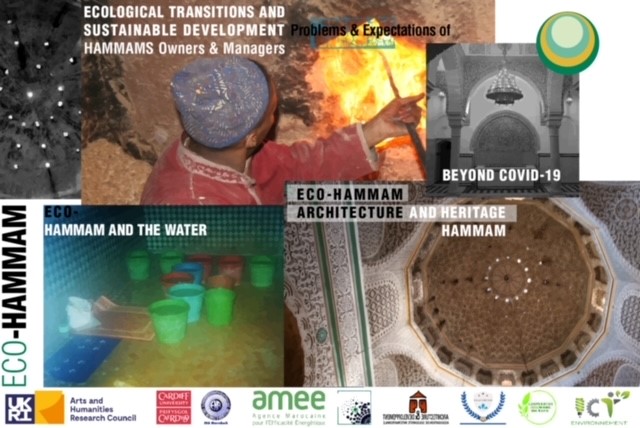Accelerating the uptake of low carbon technologies and ecological practices at a time of crisis.
Eco-hammam asks if the hammam sector in Morocco could benefit from the systematic engagement of multiple stakeholders and their coordinated collaboration, for accelerating the uptake of low carbon technologies and ecological practices at a time of crisis.

Activities
Our project activities include:
- Establishing a database of key stakeholders and designing social media and web platforms in order to facilitate interaction between these stakeholders for the duration of the project.
- Conducting monthly public engagement events (in the form of virtual forums) and network facilitation activities with a total of around 360 stakeholders from various sectors and regions in Morocco. Each virtual forum focuses on one specific area of ecological transition:
- post-COVID-19 transition scenarios and sustainable economy;
- improved indoor conditions for health, safety and wellbeing; responsible water consumption and
- recycling and energy transition.
Some engagement case study hammams from different regions are used to form the focus of multi-stakeholders' co-production of realistic and feasible scenarios for ecological transition. These events are designed to act as catalysts for self-sustaining coordinated regional processes and networks that will accelerate energy transition and ecological practices.
- Co-monitoring social media and web platforms for hammam stakeholders to assess the impact of the virtual forum events.
- Co-producing with the National Moroccan Agency for Energy Efficiency a toolkit for hammam ecological transition and a rating system for eco-hammam labelling. This will facilitate and accelerate energy and ecological transition practices as well as the implementation of new regulations by the Ministry of Energy, Mines and Sustainable Development in Morocco through its branch AMEE, one of the partners of this project.
Findings
The combination of these separate actions is expected to facilitate an integrated approach towards the co-production of holistic eco-hammam practices and the acceleration of their implementation.
The outcomes of this project are GCRF and ODA compliant as they contribute to the following key areas of global sustainable development goals: Sustainable health and wellbeing, clean air, water and sanitation and affordable, reliable, sustainable energy.
The hammam sector in Morocco is currently in a crisis due to its ongoing closure during the Covid-19 pandemic.
Impact
The impact of this project is that it addresses Morocco National priorities in terms of achieving the following:
- Environmental sustainability: reducing deforestation in Morocco by increasing hammam managers awareness of the use of biomass and efficient boilers and increasing their capacity to source biomass and integrate renewable energy technologies.
- Increasing opportunities for water saving and recycling, hence addressing the problems of water shortages brought about by severe draughts caused by climate change.
- Provide an opportunity of communication and collaboration between concerned Ministries in order to facilitate joint sustainable actions such as co-subsidising the installation of biomass boilers and improving hammam managers accessibility to biomass and biomass energy efficient boilers and solar water heaters.
- Improving air quality by reducing air pollution caused by the traditional hammam furnaces and their chimneys and hence improving the economic sustainability of hammams by reducing their running costs of fuel, water and electricity and hence maintaining their affordable access to the low-income population.
- Improving health and well-being of hammam staff and users by the application of health and safety measures and improving the indoor comfort in terms of daylighting natural ventilation, humidity and temperature controls. Before Covid-19 every hammam used to receive an average of 700 regular clients on a weekly basis. This project is likely to have a positive impact on the health and wellbeing of thousands of hammam users, and in parallel accelerate the safe return to pre-Covid hammam occupancy levels.
- Sustain informal and formal jobs associated with the hammam operation, management and services, hence maintaining a source of income for the most economically disadvantaged. Each hammam employs about 15 staff, men and women, therefore the project has the potential to improve the working conditions of at least 180,000 hammam workers.
- Maintaining the cultural sustainability and resilience of a living heritage of hygiene and wellbeing by allowing the tangible and intangible dimensions of this heritage to continue into the 21st century, particularly for the low-income population living in the World heritage cities of Rabat, Fes and Marrakech.
This project has the potential to be extended to other Maghreb countries of Algeria, Tunisia and Libya where the hammam is still a living heritage.